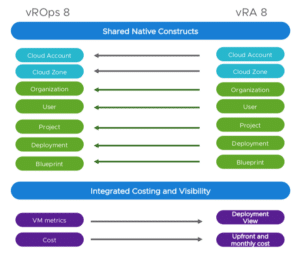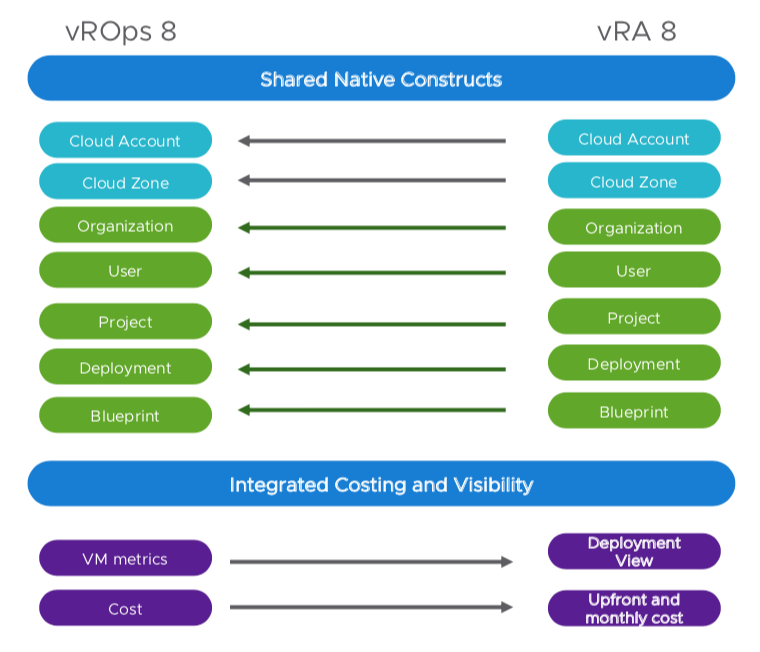As we talked in the last article, VMware announced some amazing new features during VMworld. Especially the features regarding the integration of Wavefront with vROps. In this article we’re going to discuss some of the announcements regarding automation and orchestration and talk about the new service model of VMware for on-premises customers.
Cloud Management Platform with vRA & vRO
There are lots of great announcements regarding vRA & vRO and even other platforms like Kubernetes. It is impossible to list them all up without becoming an extremely lengthy post.
However, the most important take away in my opinion is that VMware is constantly improving their “Cloud Management Platform” (CMP) and is well on track with their mission of creating a “Hybrid Cloud Platform”. With more integration between all the different products in the big portfolio of VMware, but also by integrating with solutions of other partners, (hybrid) cloud management becomes more and more manageable, controllable and automatable. Especially when making use of automation or orchestration with vRA & vRO.
In vRA 8.0, vRO 8.0 is treated as a first-class citizen. This for example enables users to manage and access content in vRA according to their permissions in vRO, or to develop orchestrator 8.0 content from the vRA interface. In general, it extends the capabilities of vRA 8.0 with vRO workflows and actions.
Another great integration is the “Shared Constructs” idea between vRA & vROps (not to confuse with vRO). The shared constructs creates a better synergy between operations and automation by using the same: Cloud Zones, Cloud Accounts, Projects, Users, Blueprints etc. This brings consistency within the different products and it can help with aligning new vRA dashboards to operational workflows. This all makes the CMP easier and more consistent, which can also help both IT and business to better understand deployment costs or even in estimating certain costs.

A new Delivery model with VMware Cloud on Dell EMC
One last announcement that I quickly want to note, is that VMware announced a new type of service model called “VMware Cloud on Dell EMC”. This new service is an on-premises delivery model with a monthly subscription. Customers can receive physical hardware onsite that will be co-engineered and delivered by Dell. The ongoing services will be fully managed by VMware. This gives business and IT several new opportunities as it combines some of the cloud advantages with on-premise advantages. For example, customers can quickly add new resources for let’s say projects, without having to invest into new hardware. At the same time, they can stay in check with data residency and regulatory requirements. It can also help organizations that want to move partly or fully to the cloud but are in the midst of a hardware renewal and / or are short on resources. This can temporarily give organizations some breathing space while making the transition. Once the need for extra on-premise resources are gone, customers can stop the monthly subscription and hardware will be taken back. I’m quite excited about this announcement since it gives organizations and businesses so much more options during projects and transitions, which helps to tackle challenges in new and different ways.
To Wrap it up
With all the new integrations and partnerships that VMware has, it becomes clear that the focus of VMware is not to try and to become a “VMware only” show. VMware could have “simply” continued with just keep acquiring and building new software and offer those as new features or technical solutions that would solve separate problems and uses cases. Instead, the vision moved towards a much bigger picture. Embracing the hybrid cloud world and help companies and organization by moving towards a consistent & transparent Hybrid Cloud Platform. One that will truly help customers to accelerate their business, whatever the choice of platform(s) or technical solutions may be.
Public Clouds as Azure & AWS, new technologies like containers, on-premise infrastructure, services like Paas, Saas, DaaS, or even VMware’s new on-premise service model, they are all just pieces that are part of a larger vision within the IT and business strategy.
By viewing IT and the diverse Platforms as one, and really trying to move away from keeping it as separate solutions that need separate tools for: automation, management, operations, monitoring, networking, gaining insight and cost control, is quite daring and difficult, but also visionary. A Hybrid Cloud Platform that wants to embrace all these different platforms, is something of which I think every organization wants and needs. VMware does this by not only delivering frameworks and multiple solutions that a customer can choose from, but by integrating these components and creating partnerships that will help customer in their Digital Journey of the Hybrid Cloud era. The fact that you can run “What-if” statement across different platforms that can help with capacity or cost-efficient choices, is an example of how this is being executed and how it can help every form of business and organization.
VMworld USA has showed that VMware really is there to bring the control back to the business and to make it truly agile, while embracing all the different IT solutions that will leverage it. Like a puzzle that becomes clear after adding more pieces, VMware’s big and impressive portfolio really unfold itself more and more with all the new announcements. It really supports their vision of embracing the hybrid cloud era, by creating a Hybrid Cloud Platform that will help customers with their Digital Transformation. Which I think is a pretty amazing and inspiring vision to go for.
What do you think about the move towards a “Hybrid Cloud Platform”? Do you love this development? Let us know on our social media channels, or contact us if you want know more.


